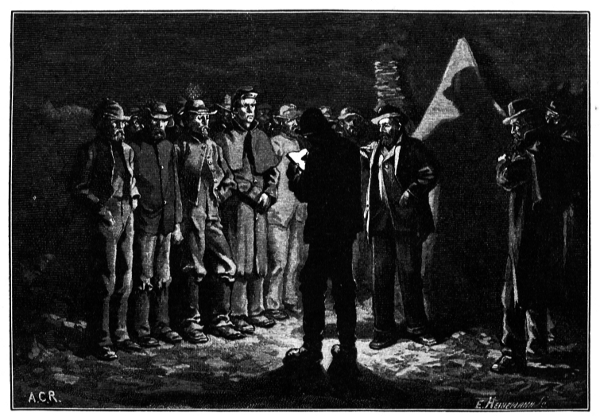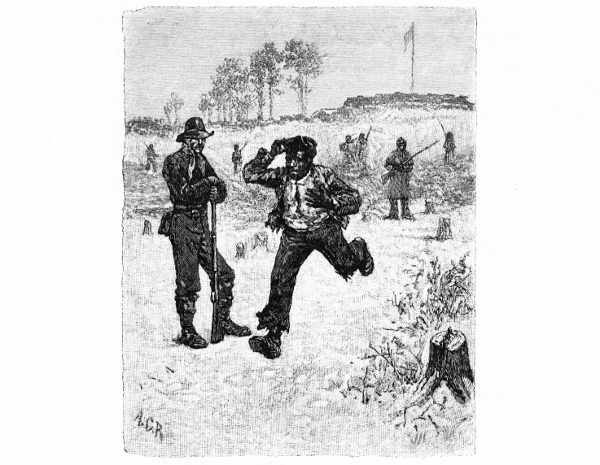Allen Christian Redwood and the 55th Virginia Regiment
1865: The Curtain Falls
In the new year of 1865, with winter again putting a stop to active operations, Redwood paid a visit to his old comrades in the 55th. The regiment occupied a heavily fortified but thinly held section of the Richmond lines opposite Fort Harrison. The artist was not prepared for what he found and his description of it remains one of the most poignant records of the last days of the Confederacy. Meeting Captain Bland of Co. C and another officer, he could not help but notice, “… in their pinched and withered faces… something indescribable which does not belong to youth or old age, but resembles some miserable travesty of the latter. It is a look which once seen is not easily forgotten;– [one in] which… the aging influences properly belonging to a life-time have been compressed within the compass of a few years. Their hair and beards are dry and harsh; their skins of the peculiar reddish-gray which comes of the combined effects of exposure and insufficient nutrition, and a feverish light in their sunken eyes tells more eloquently still of daily hunger which is never quite appeased.” The ration had now been cut to one-third of a pound of meat and a pound of corn meal per man per day – “only this and nothing more.”
The lines were a depressing sight, set in a dingy and muddy wasteland from which all trees had long since been removed. The regimental camp hugged the breast-work closely with no semblance of order in the arrangement of its quarters, which were “nondescript structures of pine-logs roofed over with clapboards,… shelter-tents, blankets, or gum-cloths, according to the constructive ability of their occupants or the resources at their command.” These huts were interspersed by a few “mildewed and smoke begrimed” tents, leaning against chinked and daubed chimneys as if for support. It was a quiet and sad place, the scant supply of fuel preventing the sort of fires that might have imparted an element of comfort.
For Redwood witnessing the roll call of Co. C was a painful experience as “the ghosts of the old company” came back to haunt him1 (Image 1):
Redwood's final record of the 55th Va. is a further homage to General Boeygyard and also a tribute to his own ability to find humour in the darkest hour. Apparently unaware that the war was coming to a close, Boeygyard conceived a plan to kidnap one of the black Union soldiers opposite and sell him back into slavery. Encouraged in this conceit by mischievous members of Mess No.5, he is shown suffering the consequences and running for dear life. Behind him are the enemy pickets and behind them, the lowering presence of Fort Harrison (Image 22):
While this was going on, Redwood was back with Lomax, facing the ruination of their hopes. The enemy had stripped the Valley bare and even east of the Blue Ridge there was not enough fodder to feed the horses. The young clerk recalled handling a report from one of Lomax's brigades stating there were only sixty-four horses for duty; its commander adding in his own hand, “This includes every horse of my brigade that can stand…”3 Redwood lost two horses himself and was granted a furlough to steal one from the enemy. In March 1865 he and several comrades set out for Suffolk in south-eastern Virginia. They attempted night-time raids on enemy picket posts, but were unable to bring away any mounts. Finally, on April 7th, just two days before General Lee's surrender at Appomattox, a Yankee detachment captured him near Somerton. He was held at Camp Hamilton Military Prison at Fort Monroe for three weeks and then transferred to Newport News before finally being released on July 3rd with permission to go to his relatives in North Carolina. His release papers stated he had blue eyes, dark hair, a light complexion and was 5' 11" tall.4
Notes
1 Scribner's Monthly, Vol. XVII, pages 534-536.
2 Ever since a Union army commander had tried to pass off a retreat as a “change of base” the term had become a joke in the Confederate Army. It is noteworthy that the Virginian units opposite Fort Harrison were content to coexist with the troops of Butler's black corps; unlike units from the western states, who sniped at them mercilessly until the last days of the war.
3 Journal of the Military Service Institution, Vol. XLIX, 1911, page 120.
4 Redwood's Compiled Service Record, U.S. National Archives, M-321, roll 5.

